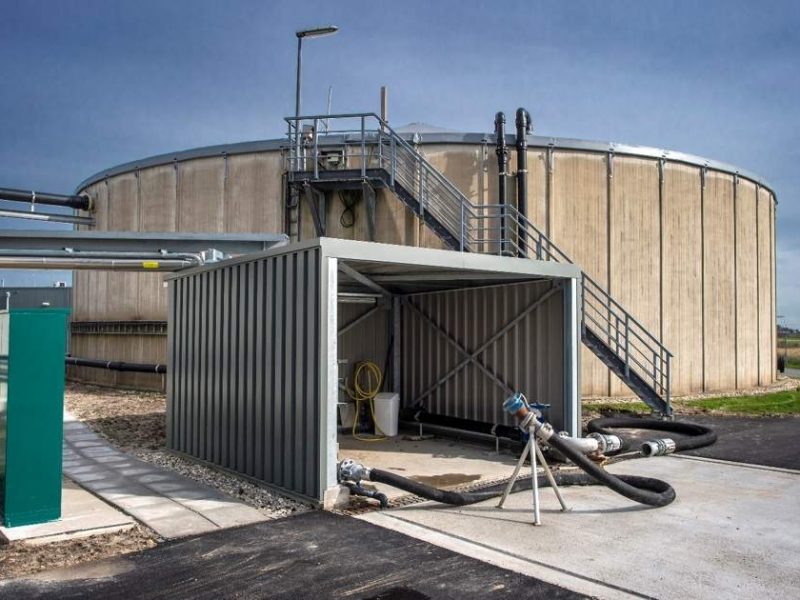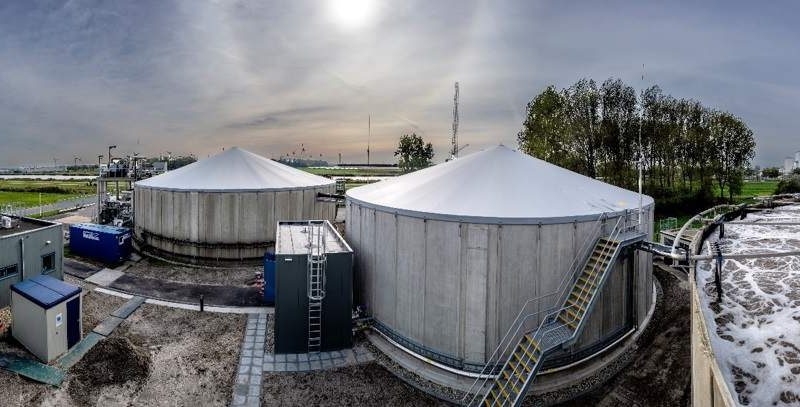North Water Saline Wastewater Treatment Plant: Experts in Brine
Since 2008, North Water Afvalwater B.V. (a wholly owned subsidiary of North Water B.V.) has been the owner and operator of the saline wastewater treatment plant in Farmsum, known by its Dutch acronym “ZAWZI”. This plant provides biological treatment of collective industrial wastewater from companies in and around the Chemical Park in Delfzijl.
North Water Saline Wastewater Treatment Plant: Experts in Brine
Brine is water that is completely or nearly completely saturated with salt (NaCl), or in other words: water with high salinity (salt content). Brine is used in cheesemaking and in food preservation. This is called brining.
A Sustainable Solution for Brine Wastewater from Cheese Factories
Since 2008, North Water Afvalwater B.V. (a wholly owned subsidiary of North Water B.V.) has been the owner and operator of the saline wastewater treatment plant in Farmsum, known by its Dutch acronym “ZAWZI”. This plant provides biological treatment of collective industrial wastewater from companies in and around the Chemical Park in Delfzijl.
The collective wastewater from these companies is saline in composition, with a chloride concentration roughly the same as that of seawater. After treatment, in which microorganisms in the activated sludge remove the impurities, the treated water (effluent) is discharged onto the saline surface water and flows out to the Wadden Sea. The salt present in the wastewater is not removed because it is predominantly sodium chloride, also known as table salt, which is also present in the sea.
The Brine Treatment Process
Wastewater purification under saline conditions and effluent discharge onto saline surface water also appears to offer a solution for regional companies in the Northern Netherlands. For instance, during production cheese producers brine cheeses in saltwater baths – up to ten times saltier than seawater.
Over time, this salt solution becomes contaminated with cheese residues, such as phosphate and organic components. The amount of brine increases due to a process called osmosis, resulting in excess brine. The brine is filtered to remove impurities such as cheese residues. These two processes produce a wastewater stream.
Cheese factories are not normally located by the sea. Local biological treatment of this wastewater is in fact possible, but the salt ends up in the inland surface water (river, lake or canal), which is freshwater, meaning saltwater discharge is undesirable (salinization).
The Challenge of Brine Disposal
Since 2014, disposal of this brine with the ZAWZI has become more efficient. The wastewater is now purified of the phosphate, organic components and nitrogen by means of organisms accustomed to saline conditions. The effluent is then discharged onto saline surface water.
The brine volumes are relatively low, and most Dutch cheese factories are in the north of the country. Because transport distances are relatively short, the ZAWZI offers excellent conditions for efficient brine treatment. The brine supply has risen steadily since 2014.
Weekly brine volumes fluctuate with cheese production cycles. For the ZAWZI, handling the salt and organic components is no problem at variable brine volumes. However, brine also contains high levels of phosphate. The daily amount of phosphate that the ZAWZI can handle also fluctuates. This capacity depends on microorganism growth, which in turn hinges on the pollution load discharged by the Chemical Park.
In addition, these companies have periods of higher and lower production (more and less wastewater). The ZAWZI applies a discharge standard for phosphate in the effluent, which limits brine throughput in periods of peak supply and/or limited phosphate processing capacity. This is not so great for cheese factories, because it means we have to stop intake and cannot guarantee continuity.
The reverse ican also be also true: sometimes the ZAWZI organisms need phosphate for proper industrial wastewater processing (adequate microorganism growth), but little to no brine is available. Until 2014, North Water had to add phosphoric acid to ensure proper biological functioning.
Since then, brine processing has supplanted that chemical dosing, thus boosting sustainability. However, the ZAWZI has since seen periods of limited brine supply, requiring temporary phosphate dosing, which is therefore still retained as a backup measure.
Continuous Biological Treatment: Efficiency is Sustainable
In 2019, North Water built a dedicated brine buffer tank at the ZAWZI. We discharge loads of brine to the tank for controlled dosing to the biological treatment system. This way, the plant can almost always receive brine: the buffer absorbs the supply in excess of processing capacity. When supply drops off and the organisms need phosphate, the buffer tank is drained. Above all, this guarantees compliance with the discharge standard for phosphate in effluent. Before construction and implementation, agreements with cheese factories were conditional, in order to guarantee a majority of the supply.
The company DOC Kaas B.V. found North Water to be an excellent partner for supply and processing agreements! This means DOC Kaas now enjoys a guaranteed facility for responsible and recognized processing of its brine, thus minimizing environmental impact.
For this, the New Production Construction department of the utility Waterbedrijf Groningen (the other shareholder in North Water, aside from Evides Industriewater) managed to build a buffer within a short period of time. In February 2019, a team started sketching out the brine buffer and associated fittings, piping, automation and roads. After the permit application, we held a brief but intensive tender procedure, with the key selection criteria focusing not only on money, but also on time.
Ultimately, we transformed an empty field (between existing facilities) into an operational buffer and pumping station – and the first truck unloaded its brine within just 12 weeks. The photos on this page (Figures 1 and 2) show the buffer tank, with unloading facilities for trucks with their own pumps as well as pumpless trucks. This enables us to accommodate trucks from different cheese factories.

Figure 1: the brine buffer tank, with truck connection facilities in the foreground

Figure 2: the North Water Afvalwater B.V. ZAWZI in Farmsum, with the biological treatment facility at right and the dedicated brine buffer tank at center. The tank at left is a similar buffer tank, but this one balances the supply of industrial wastewater from the Chemical Park, such as when an influx of rainwater reduces the salinity of the collective wastewater supply.
ZAWZI: the Next Generation of Buffer Tanks
Now that the buffer is complete and in operation, we look to the future. The brine supply in the Northern Netherlands region is greater than what the ZAWZI can currently handle in terms of phosphate – even with the new buffer, and assuming we do not see a significant increase in activity and wastewater production in Delfzijl (adequate potential).
Back in 1972, the Club of Rome announced that there are “Limits to Growth”. However, we see an opportunity in this. Thanks to its special buffer for brine, North Water always has a certain volume of brine available onsite. This brine contains both calcium and phosphate in dissolved form.
Under the right circumstances, these substances form solid particles (precipitate). And North Water can likely control these conditions to ensure (i) adequate phosphate left over for the organisms and (ii) calcium phosphate production. These particles must then be removed from the buffer tank in a controlled manner, after which various companies can use this material to produce artificial fertilizer. This may be up to around 100 metric tons of calcium phosphate per year, which is certainly no small amount.
Economies of scale are in fact vital in calcium phosphate production to also make this a viable business case. This means that in time (once controlled calcium phosphate removal is actually possible), we can conclude agreements with multiple cheese factories to guarantee brine purchases. Quite an elegant cycle, if we do say so ourselves! The material produced from the brine is used as raw material for artificial fertilizer, so it returns to the grass, ultimately to become cheese again!
An added bonus is that North Water will have two ways to remove phosphate (biologically and as a raw material), thus boosting brine throughput and enabling timely and efficient processing of practically all brine in the Northern Netherlands region. This is performed under saline conditions, with simple discharge of salt to the sea, and without any salt ending up in inland bodies of fresh surface water. We are currently researching these opportunities, and also looking for prospective partners in this endeavor.
Wetsus (the European center of excellence for sustainable water technology, in Leeuwarden) has an idea to use electrochemical phosphate precipitation for this. This method, which they are currently testing, would actually only require electricity, which would naturally have to be sustainable. We are highly curious about the opportunities for proper and sustainable use of this method. We also expect that cheese producers other than DOC Kaas will also benefit from this development in terms of continuity and sustainable brine treatment.
